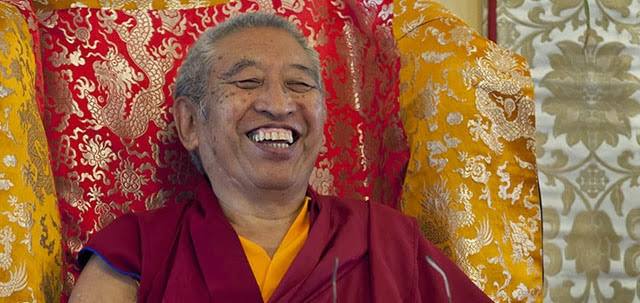Khenchen Thrangu Rinpoche: Appearances Are Mind

Khenchen Thrangu Rinpoche
In the Ninth Karmapa’s great Mahamudra text called, ‘The Ocean of Definitive Meaning’, he presents three ways in which one can directly recognize the nature of the mind: looking at the mind within stillness; looking at the mind within movement; and looking at the mind within appearances. If any one of these approaches brings recognition, then that is sufficient, so if you are not able to recognize the mind’s nature through one method, try another. Here we are going to talk about the last method, looking at the mind within appearances.
Gampopa said,
‘Appearances and mind are one’, but in our normal way of perceiving this is not the case. We assume we are perceiving external objects, and we assume that the perceiver is our internal mind. These seem to be two separate things. But Gampopa is telling us that appearances have no external existence; they are none other than mind itself. How can this be?
Gampopa also said that the mind is the innate awareness of the dharmakaya, and appearances are the innate light that arises within the dharmakaya. This is another way of saying that all ‘appearances are none other than mind’. Still – how do we experience this for ourselves? How are we going to develop certainty about this union of appearances and awareness?
We do this by hearing the dharma, by being introduced to our own mind, and ultimately through direct meditative realization. In this regard, no matter which of the three methods we use, we have to develop the basic skill of meditation. This is as follows. If the mind is in stillness, meditate on that stillness; if the mind is in movement, meditate on that movement; if a defilement should arise, meditate on that defilement. If happiness or unhappiness arises, meditate on that. But, don’t get swept away in a discursive train of thought or emotional upheaval. Whatever arises, meditate mindfully upon it and recognize its nature as emptiness and clarity. It always comes back to this.
When I was quite young and began to study these texts, the first thing about emptiness that I encountered in my study was the presentation of selflessness. When I first studied this, I thought it was ridiculous because I was being told that my mind did not exist. I thought, “Well, that is weird. I know my mind exists.” But when I analyzed my mind according to the reasoning of various scholars and siddhas, I became certain in the sense of conceptual understanding that a personal self does not exist.
When I continued my studies, I was exposed to the idea that not only the personal self but all phenomena lacked true existence in that same way. I thought, ‘Well, it is true that the personal self does not exist; this has been proven to me. But to say that all things are empty is going too far. After all, I see things; I hear things, and so on. How can these be nonexistent?’ Then when I encountered the reasoning of the middle way school, I realized that I had been wrong again. It was true that phenomena lacked any substantial existence. At that point I developed certainty based upon a theoretical or conceptual understanding of the selflessness of persons and the selflessness of phenomena.
Following this, I was advised by my tutors that theoretical understanding alone was not enough. They began to encourage me to experience my own mind without conceptual analysis. They said, ‘If you look at your mind, a direct experience is possible.’ When I started to look at my mind, I became convinced that emptiness is not something distant from us. It is not something that we have to turn outwards to discover. It is always potentially available to us as a direct experience. What I am saying to you is that these doctrines are not mere superstition. They can be validated through direct valid cognition.
I mention all this because Karmapa presents four statements on recognizing the nature of mind through appearances. He says:
“Appearances are mind;
Mind is emptiness;
Emptiness is spontaneous presence; and
Spontaneous presence is self-liberation.
On the face of it, these four statements may sound somewhat grandiose and unverifiable. But if you actually go through the Mahamudra practices, you will be able to experience the truth of these assertions through direct valid cognition. This is the true path to the realization of buddha-nature.
~ Khenchen Thrangu Rinpoche
Adapted from transcripts of his 1998 retreat in Maine, USA on ‘The Ninth Karmapa’s Ocean of Definitive Meaning’. Translations by Peter Alan Roberts and Lama Tashi Namgyal.